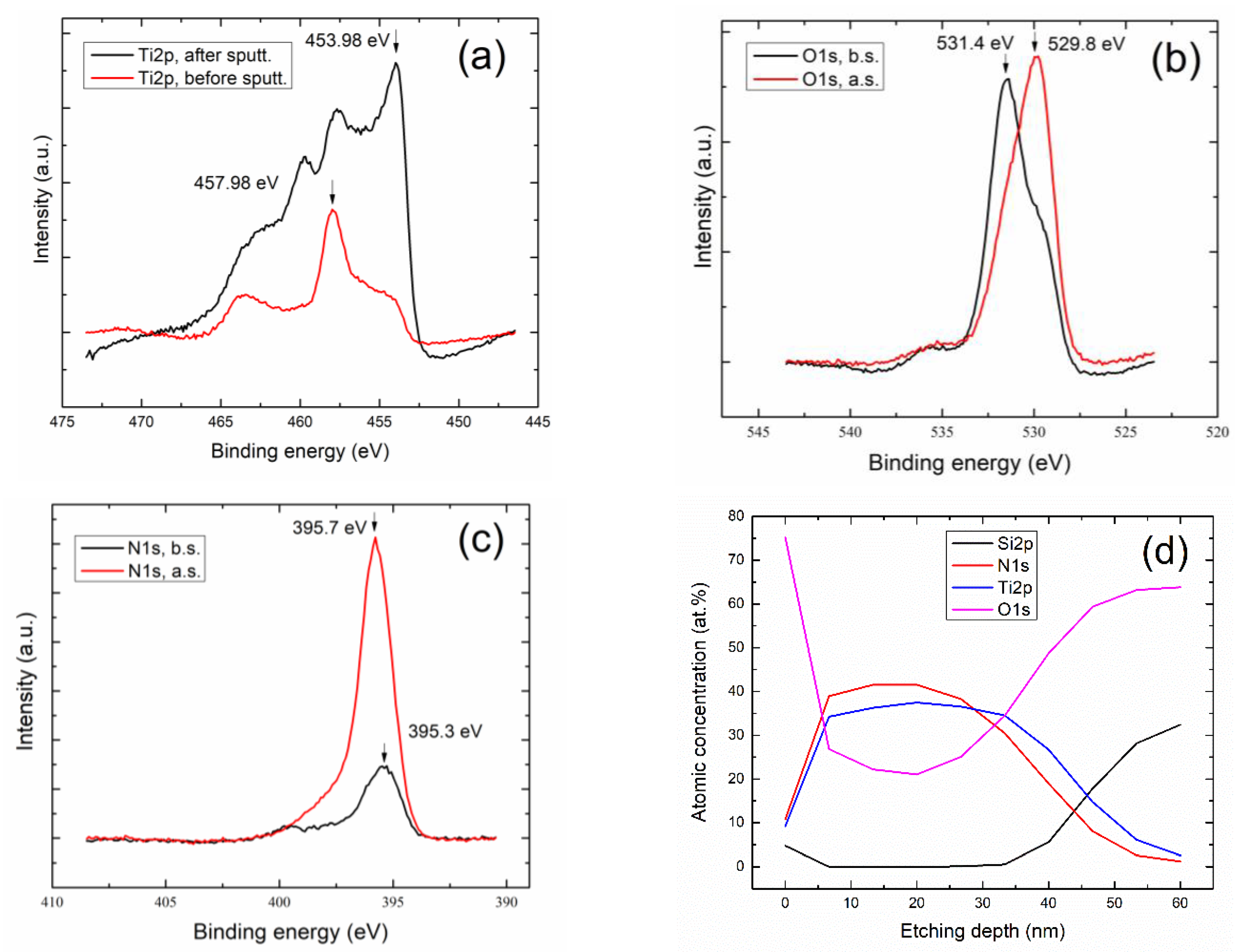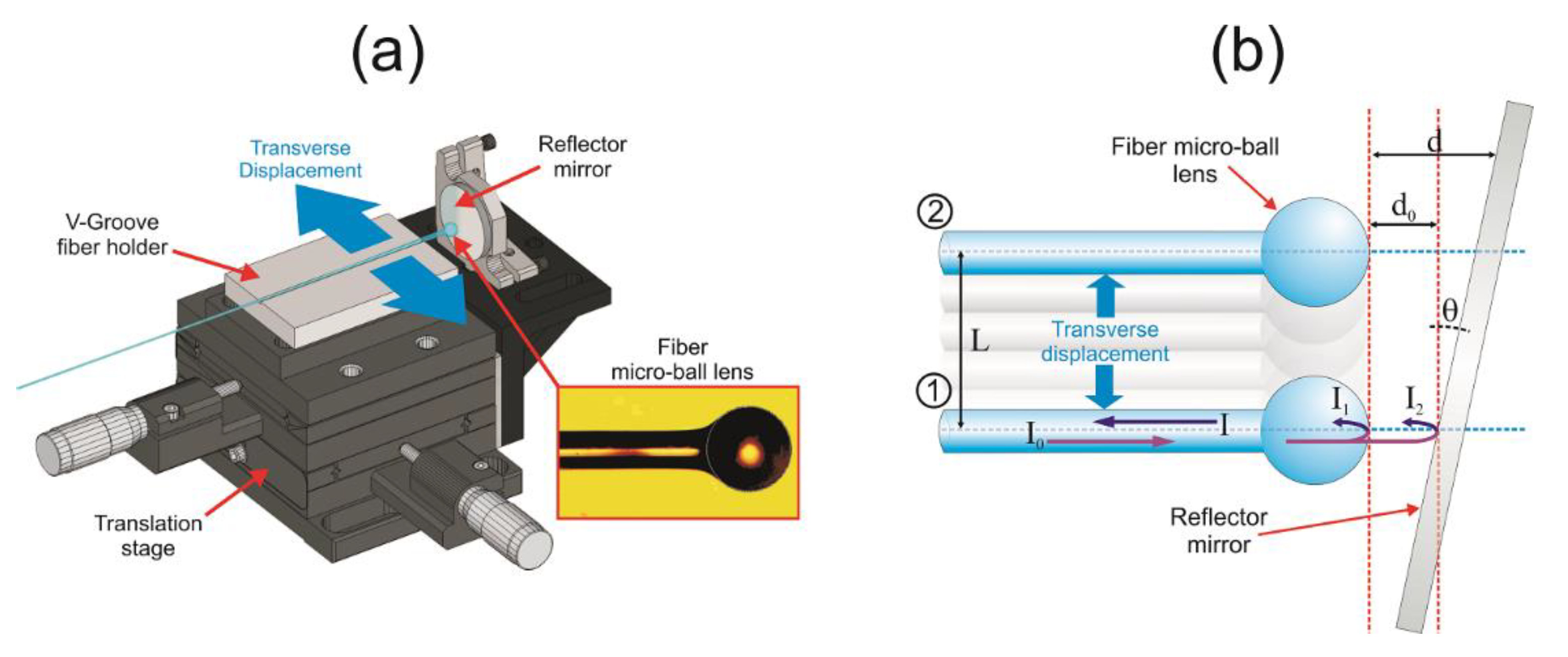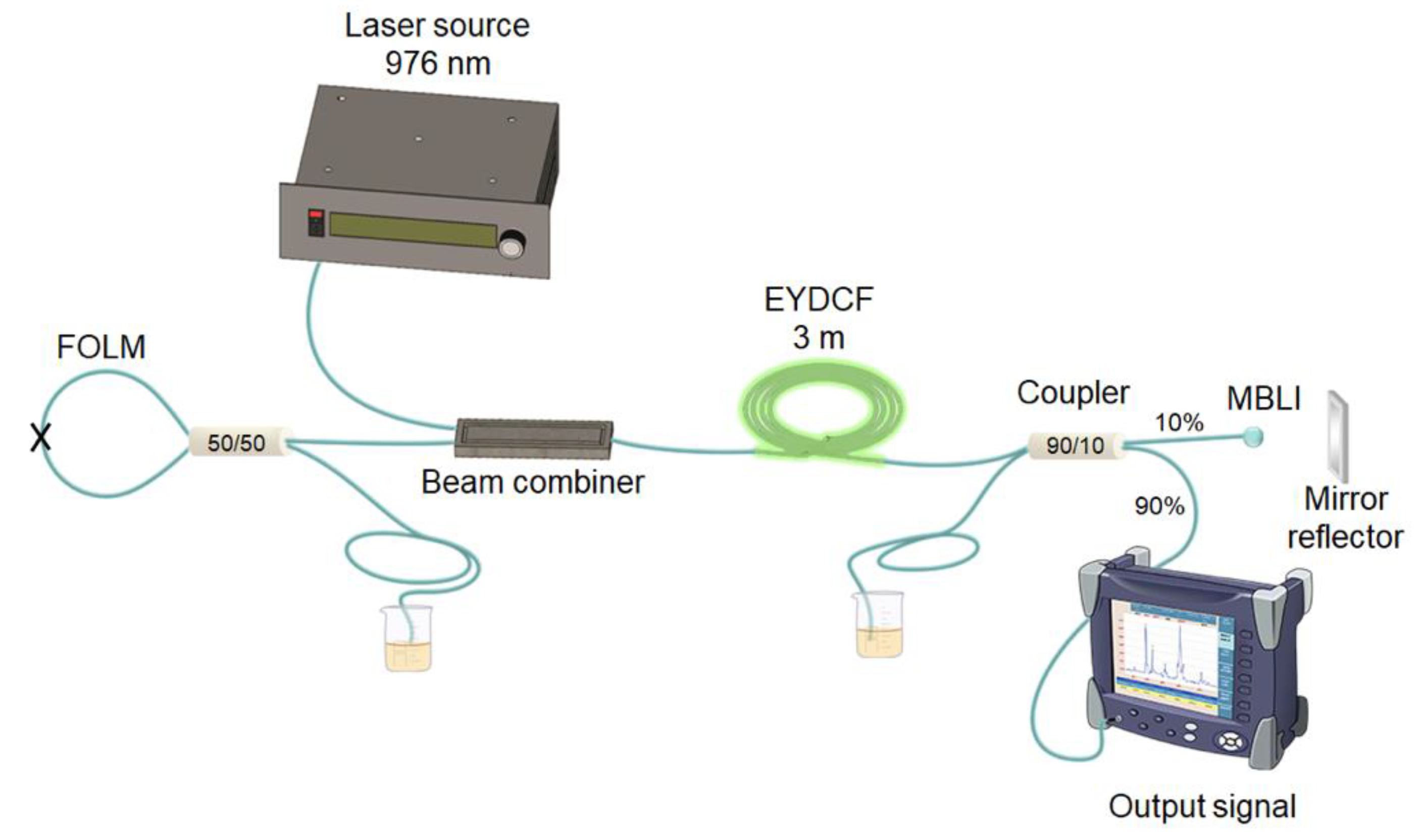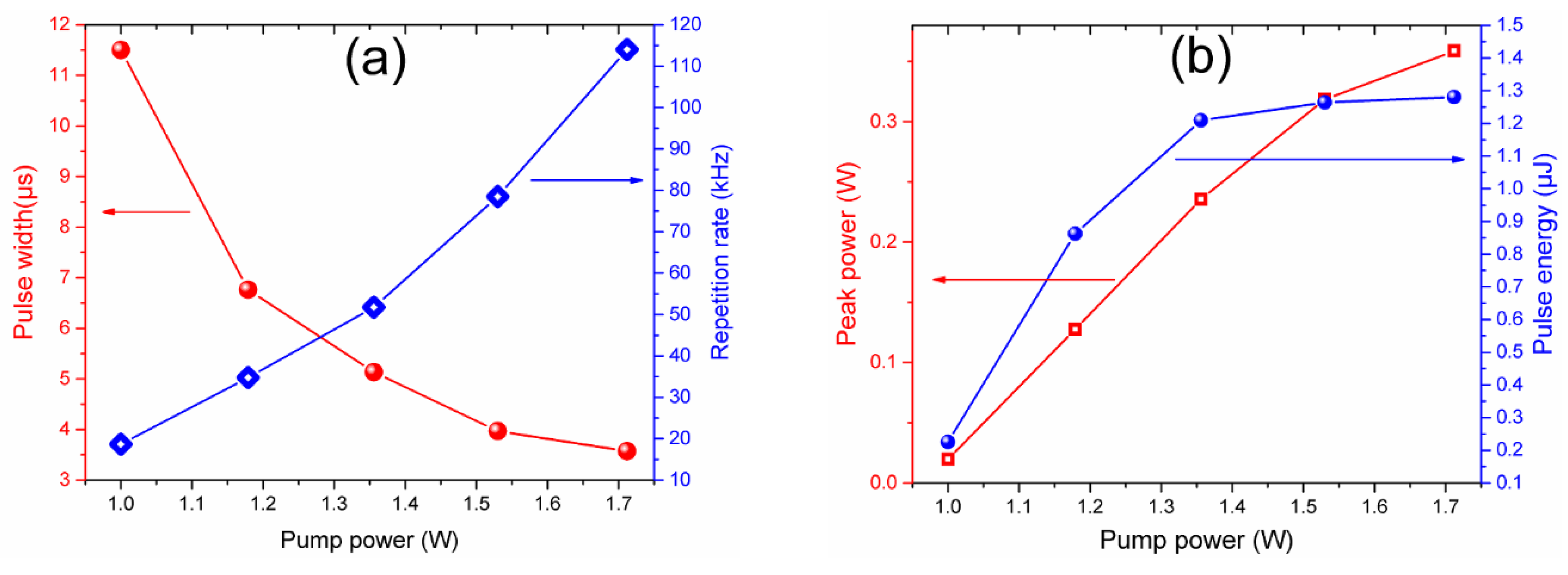TiOxNy Thin Film Sputtered on a Fiber Ball Lens as Saturable Absorber for Passive Q-Switched Generation of a Single-Tunable/Dual-Wavelength Er-Yb Double Clad Fiber Laser
Abstract
1. Introduction
2. Fiber MBL Coated with TiOxNy Thin Film
2.1. MBL Fabrication and TiOxNy Thin Film Deposition
2.2. TiOxNy Coating Characterization
2.3. Nonlinear Optical Absorption Characterization
2.4. Fiber Micro-Ball Lense Interfoerometer Setup and Operation Principle
3. PQS Tunable EYDCF Laser
3.1. Experimental Setup
3.2. Results and Discussion
4. Conclusions
Author Contributions
Funding
Acknowledgments
Conflicts of Interest
References
- Skorczakowski, M.; Swiderski, J.; Pichola, W.; Nyga, P.; Zajac, A.; Maciejewska, M.; Galecki, L.; Kasprzak, J.; Gross, S.; Heinrich, A.; et al. Mid-infrared Q-switched Er:YAG laser for medical applications. Laser Phys. Lett. 2010, 7, 498–504. [Google Scholar] [CrossRef]
- Piao, Z.; Zeng, L.; Chen, Z.; Kim, C.S. Q-switched erbium-doped fiber laser at 1600 nm for photoacoustic imaging application. Appl. Phys. Lett. 2016, 108, 143701. [Google Scholar] [CrossRef] [PubMed]
- Laroche, M.; Chardon, A.M.; Nilsson, J.; Shepherd, D.P.; Clarkson, W.A.; Girard, S.; Moncorge, R. Compact diode-pumped passively Q-switched tunable Er-Yb double-clad fiber laser. Opt. Lett. 2002, 27, 1980–1982. [Google Scholar] [CrossRef] [PubMed]
- Bao, Q.; Zhang, H.; Ni, Z.; Wang, Y.; Polavarapu, L.; Shen, Z.; Xu, Q.H.; Tang, D.; Loh, K.P. Monolayer graphene as a saturable absorber in a mode-locked laser. Nano Res. 2010, 4, 297–307. [Google Scholar] [CrossRef]
- Popa, D.; Sun, Z.; Hasan, T.; Torrisi, F.; Wang, F.; Ferrari, A.C. Graphene Q-switched, tunable fiber laser. Appl. Phys. Lett. 2011, 98, 073106. [Google Scholar] [CrossRef]
- Zhou, D.; Wei, L.; Dong, B.; Liu, W. Tunable passively Q-switched erbium-doped fiber laser with carbon nanotubes as a saturable absorber. IEEE Photonics Technol. Lett. 2010, 22, 9–11. [Google Scholar] [CrossRef]
- Dong, B.; Hao, J.; Hu, J.; Liaw, C. Short linear-cavity Q-switched fiber laser with a compact short carbon nanotube based saturable absorber. Opt. Fiber Technol. 2011, 17, 105–107. [Google Scholar] [CrossRef]
- Oreshkov, B.; Veronesi, S.; Tonelli, M.; Lieto, A.; Petrov, V.; Griebner, U.; Mateos, X.; Buchvarov, I. Tm3+:LiGdF4 laser, passively Q-switched with a Cr2+: ZnSe saturable absorber. IEEE Photonics J. 2015, 7, 1502206. [Google Scholar] [CrossRef]
- Dussardier, B.; Maria, J.; Peterka, P. Passively Q-switched Ytterbium- and Chromium-doped all-fiber laser. Appl. Opt. 2011, 50, 20–23. [Google Scholar] [CrossRef]
- Laroche, M.; Gilles, H.; Girard, S.; Passilly, N.; Aït-Ameur, K. Nanosecond pulse generation in a passively Q-switched Yb-doped fiber laser by Cr4+: YAG saturable absorber. IEEE Photonic. Tech. L. 2006, 18, 764–766. [Google Scholar] [CrossRef]
- Yang, X.; Ma, Z.; Zheng, L.; Shang, L.; Su, F. An LD-pumped dual-wavelength actively Q-switched Nd: Sc0.2Y0.8SiO5 laser. Opt. Lett. 2015, 11, 92–94. [Google Scholar] [CrossRef]
- Luo, Z.; Liu, C.; Huang, Y.; Wu, D.; Wu, J.; Xu, H.; Cai, Z.; Lin, Z.; Sun, L.; Weng, J. Topological-insulator passively Q-switched double-clad fiber laser at 2 μm wavelength. IEEE J. Sel. Top Quant. 2014, 20, 0902708. [Google Scholar]
- Liu, M.; Zhao, N.; Liu, H.; Zheng, X.W.; Luo, A.P.; Luo, Z.C.; Xu, W.C.; Zhao, C.J.; Zhang, H.; Wen, S.C. Dual-wavelength harmonically mode-locked fiber laser with topological insulator saturable absorber. IEEE Photonic Technol. Lett. 2014, 26, 983–986. [Google Scholar]
- Gui, L.; Bagheri, S.; Strohfeldt, N.; Hentschel, M.; Zgrabik, C.M.; Metzger, B.; Linnenbank, H.; Hu, E.L.; Giessen, H. Nonlinear Refractory Plasmonics with Titanium Nitride Nanoantennas. Nano Lett. 2016, 16, 5708–5713. [Google Scholar] [CrossRef]
- Rusdia, M.F.M.; Latiff, A.A.; Paulc, M.C.; Dasc, S.; Dharc, A.; Ahmadb, H.; Haruna, S.W. Titanium Dioxide (TiO2) film as a new saturable absorber for generating mode-locked thulium-holmium doped all-fiber laser. Opt. Laser Technol. 2017, 89, 16–20. [Google Scholar] [CrossRef]
- Graciani, J.; Fdez Sanz, J.; Asaki, T.; Nakamura, K.; Rodriguez, J.A. Interaction of oxygen with TiN(001) N↔O exchange and oxidation process. J. Chem. Phys. 2007, 126, 244713. [Google Scholar] [CrossRef]
- Heřman, D.; Šícha, J.; Musil, J. Magnetron sputtering of TiOxNy films. Vacuum 2006, 81, 285–290. [Google Scholar] [CrossRef]
- Martin, N.; Banakh, O.; Santo, A.M.E.; Springer, S.; Sanjinés, R.; Takadoum, J.; Lévy, F. Correlation between processing and properties of TiOxNy thin films sputter deposited by the reactive gas pulsing technique. Appl. Surf. Sci. 2001, 185, 123–133. [Google Scholar] [CrossRef]
- Liang, H.; Xu, J.; Zhou, D.; Sun, X.; Chu, S.; Bai, Y. Thickness dependent microstructural and electrical properties of TiN thin films prepared by DC reactive magnetron sputtering. Ceram. Int. 2016, 42, 2642–2647. [Google Scholar] [CrossRef]
- Braic, L.; Vasilantonakis, N.; Mihai, A.; Villar Garcia, I.J.; Fearn, S.; Zou, B.; Alford, N.M.N.; Doiron, B.; Oulton, R.F.; Maier, S.A.; et al. Titanium oxynitride thin films with tunable double epsilon-near-zero behavior for nanophotonic applications. ACS Appl. Mater. Interfaces 2017, 9, 29857–29862. [Google Scholar] [CrossRef]
- Lee, J.S.; Chung, Y.C.; DiGiovanni, D.J. Spectrum-sliced fiber amplifier light source for multichannel WDM applications. IEEE Photonics Technol. Lett. 2013, 5, 1458–1461. [Google Scholar] [CrossRef]
- Ibarra Escamilla, B.; Durán Sánchez, M.; Álvarez Tamayo, R.I.; Posada Ramírez, B.; Prieto Cortés, P.; Kuzin, E.A.; Cruz, J.L.; Andrés, M.V. Tunable dual-wavelength operation of an all-fiber thulium-doped fiber laser based on tunable fiber Bragg gratings. J. Opt. 2018, 20, 085702. [Google Scholar] [CrossRef]
- Liu, D.; Wu, Q.; Mei, C.; Yuan, J.; Xin, X.; Kumar, A.M.; Wei, F.; Han, W.; Kumar, R.; Yu, C.; et al. Hollow core fiber based interferometer for high-temperature (1000 °C) measurement. J. Lightwave Technol. 2017, 36, 1583–1590. [Google Scholar] [CrossRef]
- Peng, W.J.; Yan, F.P.; Li, Q.; Liu, S.; Feng, T.; Tan, S.Y.; Feng, S.C. 1.94 μm switchable dual-wavelength Tm3+ fiber laser employing high-birefringence fiber Bragg grating. Appl. Opt. 2013, 52, 4601–4607. [Google Scholar] [CrossRef] [PubMed]
- Wang, Y.; Zhou, Y.; Yan, S.; Tang, Y.; Xu, J. Dual-Wavelength 2-μm fiber laser with coupled fiber bragg grating cavities. IEEE Photonics Technol. Lett. 2016, 28, 1193–1196. [Google Scholar] [CrossRef]
- Iadicicco, A.; Cusano, A.; Cutolo, A.; Bernini, R.; Giordano, M. Thinned fiber Bragg gratings as high sensitivity refractive index sensor. IEEE Photonics Technol. Lett. 2004, 16, 1149–1151. [Google Scholar] [CrossRef]
- Mehta, A.; Mohammed, W.; Johnson, E.G. Multimode interference-based fiber-optic displacement sensor. IEEE Photonics Technol. Lett. 2003, 15, 1129–1131. [Google Scholar] [CrossRef]
- Leuthold, J.; Hess, R.; Eckner, J.; Besse, P.A.; Melchior, H. Spatial mode filters realized with multimode interference couplers. Opt. Lett. 1996, 21, 836–838. [Google Scholar] [CrossRef]
- Ouyang, C.; Shum, P.; Wang, H.; Fu, S.; Cheng, X.; Wong, J.H.; Tian, X. Wavelength-tunable high-energy all-normal-dispersion Yb-doped mode-locked all-fiber laser with a HiBi fiber Sagnac loop filter. IEEE J. Quantum Electron. 2011, 47, 198–203. [Google Scholar] [CrossRef]
- Yang, R.; Yu, Y.S.; Xue, Y.; Chen, C.; Chen, Q.D.; Sun, H.B. Single S-tapered fiber Mach–Zehnder interferometers. Opt. Lett. 2011, 36, 4482–4484. [Google Scholar] [CrossRef]
- Liu, L.; Lu, P.; Liao, H.; Wang, S.; Yang, W.; Liu, D.; Zhang, J. Fiber-optic Michelson interferometric acoustic sensor based on a PP/PET diaphragm. IEEE Sens. J. 2016, 16, 3054–3058. [Google Scholar] [CrossRef]
- Yin, X.; Zhou, R. Compact vector fiber-optic displacement sensor using an asymmetric Mach–Zehnder interferometer. Opt. Commun. 2017, 400, 74–78. [Google Scholar] [CrossRef]
- Eom, J.B. Ball Lens Based Common path fiber optic interferometer sensor. J. Biosens. Bioelectron. 2015, 6, 1. [Google Scholar]
- Harun, S.W.; Jasim, A.A.; Rahman, H.A.; Muhammad, M.Z.; Ahmad, H. Micro-ball lensed fiber-based glucose sensor. IEEE Sens. J. 2012, 13, 348–350. [Google Scholar] [CrossRef]
- Jasim, A.A.; Zulkifli, A.Z.; Muhammad, M.Z.; Harun, S.W.; Ahmad, H. A new compact micro-ball lens structure at the cleaved tip of microfiber coupler for displacement sensing. Sens. Actuator A Phys. 2013, 189, 177–181. [Google Scholar] [CrossRef]
- Ferreira, M.S.; Santos, J.L.; Frazão, O. Silica microspheres array strain sensor. Opt. Lett. 2014, 39, 5937–5940. [Google Scholar] [CrossRef]
- Van Bui, H.; Groenland, A.W.; Aarnink, A.A.I.; Wolters, R.A.M.; Schmitz, J.; Kovalgin, A.Y. Growth kinetics and oxidation mechanism of ALD TiN thin films monitored by in situ spectroscopic ellipsometry. J. Electrochem. Soc. 2011, 158, H214–H220. [Google Scholar] [CrossRef]
- Saha, N.C.; Tompkins, H.G. Titanium nitride oxidation chemistry: An x-ray photoelectron spectroscopy study. J. Appl. Phys. 1992, 72, 3072–3079. [Google Scholar] [CrossRef]
- Zaca Morán, P.; Kuzin, E.; Torres Turiján, J.; Ortega Mendoza, J.G.; Chávez, F.; Pérez Sánchez, G.F.; Gómez Pavón, L.C. High gain pulsed erbium-doped fiber amplifier for the nonlinear characterization of SWCNTs photodeposited on optical fibers. Opt. Laser Technol. 2013, 52, 15–20. [Google Scholar] [CrossRef]
- Prieto Cortés, P.; Álvarez Tamayo, R.I.; García Méndez, M.; Durán Sánchez, M.; Barcelata Pinzón, A.; Ibarra Escamilla, B. Magnetron sputtered Al-doped ZnO thin film as saturable absorber for passively Q-switched Er/Yb double clad fiber laser. Laser Phys. Lett. 2019, 16, 045101. [Google Scholar] [CrossRef]
- Irimpan, L.; Deepthy, A.; Krishnan, B.; Nampoori, V.P.N.; Radhakrishnan, P. Nonlinear optical characteristics of self-assembled films of ZnO. Appl. Phys. B 2008, 90, 547. [Google Scholar] [CrossRef]











| Deposition Time | Ar Flow | N2 Flow | d | P | Working Pressure | Thickness |
|---|---|---|---|---|---|---|
| 60 s | 20 sccm | 4 sccm | 5 cm | 200 W | 5.0 × 10−1 Pa | 40 nm |
| Transition Signal | BEs before Sputtering (eV) | BEs after Sputtering (eV) |
|---|---|---|
| Ti2p3/2 | 457.98 | 453.98 |
| O1s | 531.4 | 529.8 |
| N1s | 395.3 | 395.7 |
| Transition Signal | BEs (eV) | Description | Reference |
|---|---|---|---|
| Ti2p3/2 | 458.7 455.2 455.3 459.1 | -Ti2p in amorphous TiO2 -Ti2p in TiN -Ti2p in TiN -Ti2p in oxidized TiN | [37,38] |
| O1s | 530 ± 0.2 531.4 | -Native oxide sample -Sub-stoichiometric oxide or an oxynitride | [38] |
| N1s | 395.7 395.1 396.0 | -Intermediate oxynitride -Native oxide -Thermally bound N that is released during nitridation of Ti-O sites or in surface oxynitrides | [20,38] |
© 2020 by the authors. Licensee MDPI, Basel, Switzerland. This article is an open access article distributed under the terms and conditions of the Creative Commons Attribution (CC BY) license (http://creativecommons.org/licenses/by/4.0/).
Share and Cite
Álvarez-Tamayo, R.I.; Gaspar-Ramírez, O.; Prieto-Cortés, P.; García-Méndez, M.; Barcelata-Pinzón, A. TiOxNy Thin Film Sputtered on a Fiber Ball Lens as Saturable Absorber for Passive Q-Switched Generation of a Single-Tunable/Dual-Wavelength Er-Yb Double Clad Fiber Laser. Nanomaterials 2020, 10, 923. https://doi.org/10.3390/nano10050923
Álvarez-Tamayo RI, Gaspar-Ramírez O, Prieto-Cortés P, García-Méndez M, Barcelata-Pinzón A. TiOxNy Thin Film Sputtered on a Fiber Ball Lens as Saturable Absorber for Passive Q-Switched Generation of a Single-Tunable/Dual-Wavelength Er-Yb Double Clad Fiber Laser. Nanomaterials. 2020; 10(5):923. https://doi.org/10.3390/nano10050923
Chicago/Turabian StyleÁlvarez-Tamayo, Ricardo I., Omar Gaspar-Ramírez, Patricia Prieto-Cortés, Manuel García-Méndez, and Antonio Barcelata-Pinzón. 2020. "TiOxNy Thin Film Sputtered on a Fiber Ball Lens as Saturable Absorber for Passive Q-Switched Generation of a Single-Tunable/Dual-Wavelength Er-Yb Double Clad Fiber Laser" Nanomaterials 10, no. 5: 923. https://doi.org/10.3390/nano10050923
APA StyleÁlvarez-Tamayo, R. I., Gaspar-Ramírez, O., Prieto-Cortés, P., García-Méndez, M., & Barcelata-Pinzón, A. (2020). TiOxNy Thin Film Sputtered on a Fiber Ball Lens as Saturable Absorber for Passive Q-Switched Generation of a Single-Tunable/Dual-Wavelength Er-Yb Double Clad Fiber Laser. Nanomaterials, 10(5), 923. https://doi.org/10.3390/nano10050923





